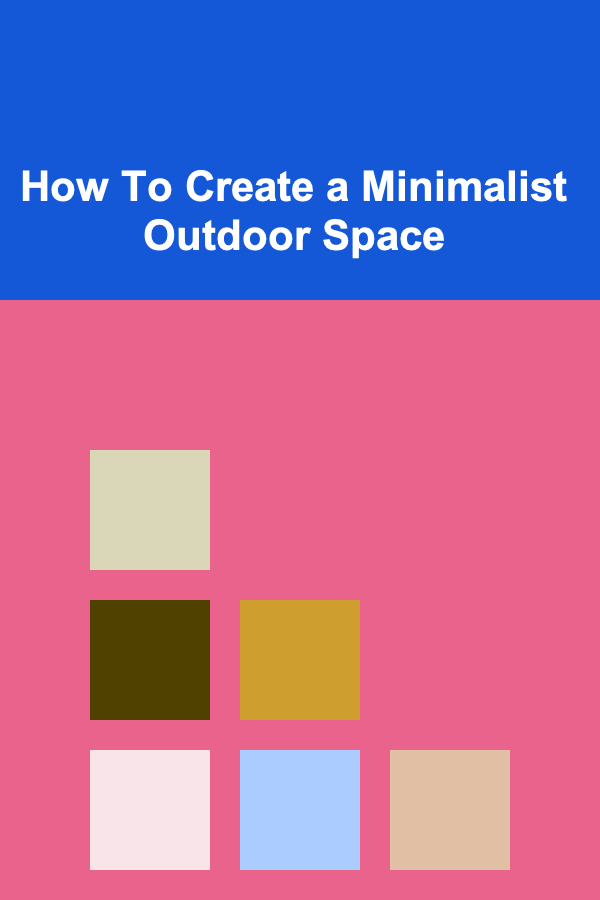
How To Create a Minimalist Outdoor Space
ebook include PDF & Audio bundle (Micro Guide)
$12.99$10.99
Limited Time Offer! Order within the next:

Creating a minimalist outdoor space involves more than just putting a few pieces of furniture together or using a basic color palette. It is about creating an environment where simplicity, function, and beauty harmonize. Minimalism, a design philosophy that emphasizes clean lines, neutral colors, and the removal of excess, can be applied to outdoor spaces to create a tranquil, functional, and visually appealing environment. In this article, we will explore how to design a minimalist outdoor space that complements your lifestyle while embracing the calming aesthetics of simplicity.
Understanding Minimalism in Outdoor Design
Minimalism is a design concept that encourages simplicity and the stripping away of unnecessary elements. This philosophy can be applied in any space, from homes and offices to gardens and outdoor patios. When it comes to outdoor spaces, minimalism involves the thoughtful selection of plants, furniture, and other design elements to achieve balance and peace.
The key to minimalist outdoor design is achieving a sense of spaciousness and tranquility. This is accomplished by eliminating clutter, focusing on high-quality materials, and embracing clean, simple lines. The goal is to create a serene environment that feels both open and inviting, while still being functional and aesthetically pleasing.
Start with a Clean Slate: Declutter Your Space
The first step in creating a minimalist outdoor space is to declutter. Minimalism thrives on clean surfaces and clear spaces. If your outdoor area is cluttered with excess furniture, old decorations, or overgrown plants, it's time to simplify.
Begin by removing any unnecessary items that don't contribute to the overall design or functionality of the space. Consider the following:
- Furniture: Remove any outdated or unnecessary furniture. In a minimalist design, less is more. You may only need a few essential pieces such as a simple outdoor sofa, a small dining table, or a lounge chair.
- Decorations: Avoid overdecorating with excessive statues, ornaments, or trinkets. A minimalist outdoor space focuses on subtle accents rather than bold decorations.
- Plants: While plants are a vital part of an outdoor space, too many can create visual clutter. Stick to a few carefully chosen plants that complement the design and atmosphere you're aiming for.
Once you've removed excess items, take note of what remains. Is there space to breathe? Are the elements well-spaced, allowing each one to stand out on its own? A minimalist outdoor space should feel open and unobstructed, inviting you to relax and enjoy the surroundings.
Focus on Simplicity in Furniture Design
Furniture plays a critical role in the overall aesthetic of your outdoor space. When designing a minimalist outdoor area, it's important to focus on simplicity, clean lines, and functionality.
Choosing the Right Pieces
Start by selecting furniture that is both practical and elegant. The best minimalist furniture pieces are those that have a sleek, modern design without being overly ornate. Here are a few tips:
- Material Choice: Opt for high-quality, durable materials such as teak, stainless steel, or powder-coated metal. These materials are not only long-lasting but also offer a clean, contemporary look.
- Neutral Tones: Stick to neutral colors like white, black, gray, or natural wood tones. These colors blend seamlessly with the natural surroundings and maintain a calm, soothing environment.
- Functional Designs: Minimalist outdoor furniture should serve a purpose. Look for versatile pieces, such as a foldable dining table or stackable chairs, which can be easily rearranged based on your needs.
- Quality Over Quantity: Instead of filling the space with multiple pieces of furniture, invest in fewer, higher-quality items. A single stylish lounge chair or a simple dining table can elevate the entire outdoor area.
Examples of Minimalist Furniture
- Modern Outdoor Sofas: A minimalist outdoor sofa is simple yet comfortable. Look for a low-profile sofa with a neutral-colored cushion and sturdy frame.
- Slimline Dining Tables: Opt for dining tables that feature sleek lines and minimalistic shapes. Materials like concrete, glass, or metal often work well in these designs.
- Functional Lighting: Choose lighting that is both beautiful and functional. A few strategically placed lanterns or LED light strips along walkways can add ambiance without cluttering the space.
Embrace Nature and the Outdoors
In minimalist outdoor design, nature is often the focal point. A minimalist space doesn't try to compete with nature; rather, it complements it. The goal is to create an environment where the surrounding natural elements can shine through.
Landscaping for Minimalism
When designing the landscape of your outdoor space, opt for simple, clean lines and limited plant varieties. Instead of creating a garden that is full of colorful flowers and diverse species, focus on a few types of plants that have a similar aesthetic or color palette. Consider the following strategies:
- Use of Grasses: Grasses are an excellent choice for minimalist gardens. Their tall, wispy nature creates a soft, flowing feel while remaining visually simple.
- Succulents and Cacti: Succulents and cacti are perfect for minimalist gardens because of their sculptural shapes and low maintenance.
- Symmetry: Use symmetry to create a balanced and harmonious outdoor space. Planting in even rows or creating mirrored designs can emphasize the minimalist aesthetic.
Hardscaping and Paths
Minimalist outdoor design often incorporates clean, geometric lines and simple materials for paths and hardscaping. Rather than intricate paving or irregularly shaped stones, opt for smooth, uniform materials like concrete, gravel, or wood. Design pathways that guide the eye through the space without overwhelming it. A simple stone or gravel path can serve as an elegant and functional addition to a minimalist garden.
Incorporating Water Elements
If you're interested in adding a water feature to your minimalist space, opt for a simple, modern design. A sleek, rectangular water fountain or a small pond with clear lines can bring a sense of calm to the space without being overwhelming.
Choose the Right Lighting
Lighting is one of the most important elements in creating an inviting minimalist outdoor space. It adds warmth and ambiance without distracting from the simplicity of the design. Choose lighting options that are unobtrusive yet effective in setting the mood.
Lighting Tips
- Subtle Outdoor Lights: Avoid harsh or overly bright lighting. Instead, use soft, warm lighting to create a relaxed atmosphere. Consider wall sconces, recessed lighting, or even string lights to add a gentle glow to the space.
- Highlighting Features: Use lighting to highlight key features in the space, such as sculptures, plants, or pathways. Low-profile spotlights or floor lamps can add interest without disrupting the minimalist aesthetic.
- Solar Lights: Solar-powered lights are an excellent option for minimalist outdoor spaces because they are both eco-friendly and low-maintenance. Place them along walkways or around seating areas to subtly illuminate the space at night.
Select Simple, Neutral Colors
In a minimalist outdoor space, color plays a critical role in setting the tone. Rather than using vibrant colors or a variety of hues, stick to a neutral color palette. Earth tones, whites, grays, and blacks are ideal for minimalist design because they blend seamlessly with the natural environment.
Color Choices for Furniture and Decor
- Furniture: Stick to neutral tones for outdoor furniture. A white, black, or gray sofa, paired with natural wood or metal finishes, will work well in a minimalist setting.
- Textiles: Cushions, throws, and rugs should also follow a neutral color scheme. Opt for white, gray, or beige fabrics that complement the outdoor setting.
- Accent Colors: If you'd like to introduce a bit of color, use accents sparingly. A single throw pillow or a potted plant can add a pop of color without overwhelming the space.
Focus on Functionality and Comfort
Minimalist design doesn't mean sacrificing comfort or practicality. In fact, simplicity often leads to a more functional and enjoyable outdoor space. When selecting furniture and accessories, always consider comfort and ease of use.
Practical Design Solutions
- Comfortable Seating: Even minimalist outdoor spaces should be inviting. Opt for ergonomic seating with cushions that provide both comfort and style. A well-placed lounge chair or a low-profile sectional can create a cozy space for relaxation.
- Storage Solutions: Keep the space clean and clutter-free by including functional storage solutions. A small storage bench can store cushions, throws, or outdoor equipment without taking up much space.
- Shade Options: If your outdoor space gets a lot of sunlight, consider adding a minimalist shade structure, such as a simple pergola or an adjustable umbrella, to ensure comfort during warmer months.
Add Personal Touches Without Overdoing It
In minimalist design, personal touches are important but should be added sparingly. Choose a few items that reflect your style and complement the overall design of the space. A single piece of artwork, a unique sculpture, or a carefully chosen vase can add personality without cluttering the area.
Conclusion
Creating a minimalist outdoor space is about embracing simplicity, functionality, and beauty. By decluttering, choosing simple furniture, embracing nature, and using neutral colors, you can transform your outdoor area into a tranquil, stylish retreat. The key to success in minimalist outdoor design is restraint---focus on the essentials and allow the space to breathe. With the right elements, a minimalist outdoor space can provide a serene sanctuary where you can unwind and connect with nature.

How to Lower Medical Expenses: Practical Tips for Reducing Healthcare Costs
Read More
How to Maintain Clear Communication with Your Team
Read More
How to Source High-Quality Products for Your Dropshipping Store from Suppliers
Read More
How to Maintain Individuality While in a Couple
Read More
How to Choose the Right Tennis Racquet for Your Style
Read More10 Tips for Creating a Minimalist Study Tracker
Read MoreOther Products

How to Lower Medical Expenses: Practical Tips for Reducing Healthcare Costs
Read More
How to Maintain Clear Communication with Your Team
Read More
How to Source High-Quality Products for Your Dropshipping Store from Suppliers
Read More
How to Maintain Individuality While in a Couple
Read More